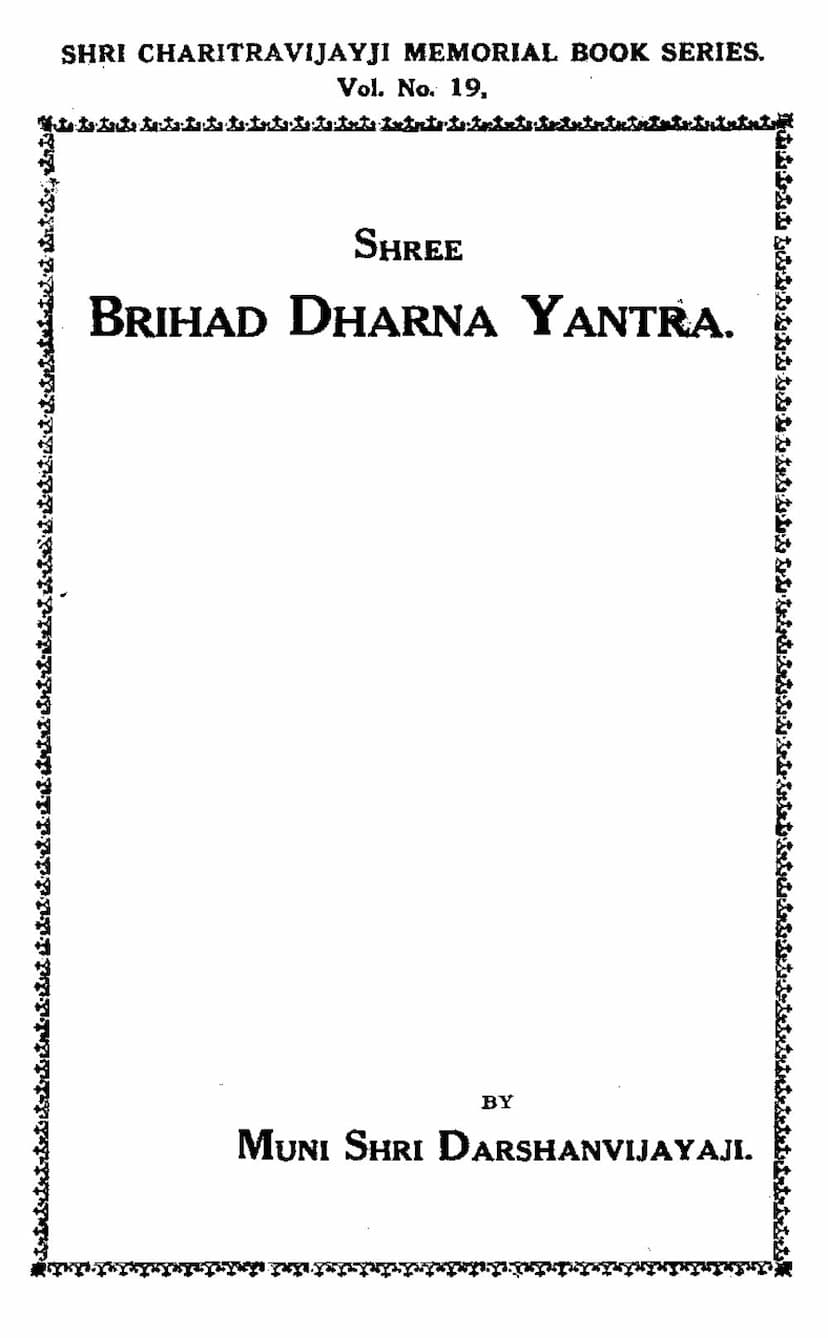Bruhad Dharana Yantra
Added to library: September 1, 2025

Summary
Here's a comprehensive summary of the Jain text "Bruhad Dharana Yantra" by Muni Shri Darshanvijay, based on the provided pages:
Book Title: Bruhad Dharana Yantra (बृहद् धारणायंत्र) Author: Muni Shri Darshanvijay (मुनि श्री दर्शनविजय) Publisher: Charitra Smarak Granthmala (श्री चारित्र स्मारक ग्रंथमाला) Catalog Link: https://jainqq.org/explore/008459/1
Overall Purpose:
The "Bruhad Dharana Yantra" is a comprehensive Jain text focused on Dharana Gati (धारणागति), which translates to "guidance" or "determination." Its primary aim is to provide a systematic method for determining the compatibility and auspiciousness of various elements in religious and personal contexts, particularly for the pratishthapana (प्रतिष्ठापना) or installation of Jain Tirthankara images (Jina-mūrti). It aims to ensure that the installed images are potent, divinely inhabited, worshipped for a long time, and bring benefits to the installer.
Key Concepts and Methodologies:
The book is structured into several chapters, each focusing on specific aspects of Dharana Gati. The core of the text involves detailed astrological and numerological calculations based on various "yantras" (यंत्राः) or diagrams and tables. These calculations analyze relationships between different elements to predict auspiciousness.
The fundamental elements analyzed are:
- Nomenclature and Astrological Letters (Namaskshara, Akshara): The initial letters of names are crucial. The text categorizes letters and their associations with various astrological factors.
- Nakshatras (नक्षत्र): The birth constellations of individuals and Tirthankaras are analyzed.
- Yoni (योनि): There are classifications of Yonis (animal associations with Nakshatras) and their compatibility.
- Taras (तारा): This refers to the star strength or positional relationship of Nakshatras.
- Gana (गण): Classifications of Ganas (groups based on astrological attributes) and their compatibility are detailed.
- Nadi (नाडी): This refers to the Nadi system in Vedic astrology, and its compatibility, including "Nadi Vedha" (नाडी वेध - Nadi affliction), is critically assessed.
- Rashi (राशि): Zodiac signs and their interrelationships (friendship, enmity, etc.) are extensively analyzed.
- Graha (ग्रह): Planetary influences and their strengths are considered.
- Varga (वर्ग): Various classifications and calculations related to numerical values associated with letters and Nakshatras.
- Virodhak (विशोपक): This refers to afflictions or inauspicious combinations.
- Yuji (युजि): Auspicious combinations or unions of various elements.
- Kut (कूट): Combinations or tables that bring together multiple factors for analysis.
- Kakshani (काकीणी): A specific calculation method, possibly involving numerical values of letters.
- Dvandampatya (दम्पत्यो): The compatibility between a couple is also discussed, particularly in relation to auspicious timings.
Core Analysis Process:
- Identifying Compatibility: The text provides tables and diagrams that link letters, Nakshatras, Ganas, Rashis, and Nadis to specific Tirthankaras.
- Determining Auspiciousness: The goal is to find Tirthankaras whose astrological and numerological attributes are compatible with the installer (Acharya, Shravaka, or the village/Sangha).
- Prioritizing Factors: While Tara strength might be less crucial for Tirthankara analysis, Gana, Rashi, and Nadi are considered essential. Incompatibility in Rashi or Nadi Vedha is deemed a strong reason to avoid a particular Tirthankara's pratishthapana. The text emphasizes that later factors (Gana, Rashi, Nadi) are more potent than earlier ones (Tara, Yoni, Varga).
- Analyzing Combinations: The book offers detailed methods for analyzing "Rashi Kut" (राशिकूट - zodiac combinations), "Varga Kut" (वर्गकूट), and "Yuji" (युजि - auspicious unions) to determine overall compatibility.
Structure and Content:
The book is meticulously organized with:
-
Mangalacharan (मंगलाचरण): Invocation and prayers.
-
Namskarana (पनाम): Salutations to gurus.
-
Chapters (Adhyaya):
- Chapter 1: Akadam-Adavokam Dwaram (अकडम्-अउओकम् द्वारं): Deals with the alphabet and its initial use in calculations. It introduces concepts like Namaskshara, Yoni, Tara, Gana, Nadi, Rashi, and their basic relationships.
- Chapter 2: Tirthankaras (लीथं कराः): Lists the 24 Tirthankaras, their associated symbols (Lanchana), Nakshatras, Yonish, Varga, Ganas, Nadis, and Rashis. This section is a foundational reference.
- Chapter 3: Akshara (अक्षराः): Further detailed analysis of letters, their groupings, and the creation of "Sarvaakshar Kut Yantra" (सर्वाक्षर कूट यंत्र).
- Chapter 4: Naming and Calculations (विन्यास ईक्षणं...): Focuses on different types of names (Janma Nam, Prasiddha Nam), their respective applications in calculations, and the concept of "Siddhi" (सिद्धि - success) based on these calculations. It also introduces "Akam Yantra" and "Siddhiadi Yantra."
- Chapter 5: Nyaasa (न्यास): This chapter is crucial for determining the "best" Tirthankara for pratishthapana. It presents detailed tables and methodologies for calculating compatibility based on the installer's name (or the community's) and the Tirthankaras. It involves analyzing various factors like Yoni, Gana, Rashi, Nadi, Tara, and Varga, with specific emphasis on their auspicious or inauspicious combinations.
-
Appendices (Parishishtani): These sections provide supplementary information:
- Viparitaksha Prakaran (विपरीक्षाप्रकरणम्): Likely deals with gem testing or material examination.
- Saptadasha Mudra (सप्तदश मुद्रा): Describes 17 specific hand gestures (mudras) used in Jain rituals.
- Dandabhogti Vichara (दंडभोत्ति विचार): Possibly relates to structural measurements or proportions in temples.
- Vachana Sangraha (वचन संग्रह): A collection of relevant sayings or verses.
- Sthapana Kalpa (स्थापनाकल्प): Detailed procedures for installation.
- Mani Pariksha (मणि परीक्षा): Detailed testing and analysis of precious stones.
- Vishesh Suchana (विशेष सूचन): Special notices or guidelines.
Key Features:
- Comprehensive Tables and Diagrams: The book is filled with intricate tables and charts that cross-reference numerous astrological and numerological factors.
- Practical Application: The text explicitly states its purpose is to guide individuals in making auspicious choices, particularly in religious installations.
- Guru-Disciple Transmission: The author mentions his guru and elder brother, highlighting the tradition of knowledge transmission.
- Emphasis on Auspiciousness: A central theme is the identification and selection of auspicious elements to ensure positive outcomes.
- Detailed Analysis of Incompatibility: The text clearly outlines combinations that are considered inauspicious and should be avoided.
In essence, "Bruhad Dharana Yantra" serves as a detailed astrological and numerological handbook for Jain pratishthapana and other important life decisions, providing a systematic framework to determine auspicious connections based on a complex interplay of names, constellations, and other celestial and symbolic factors.